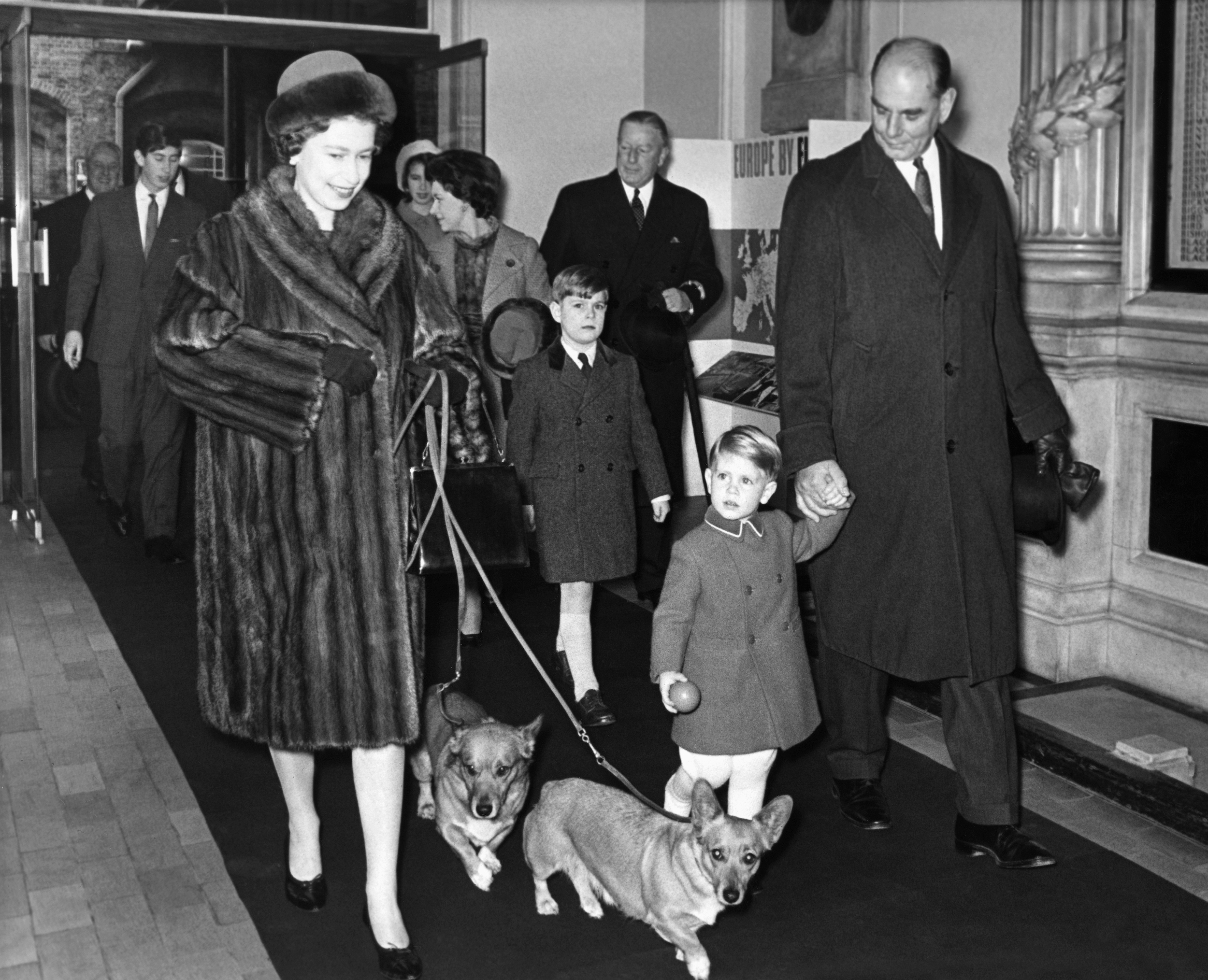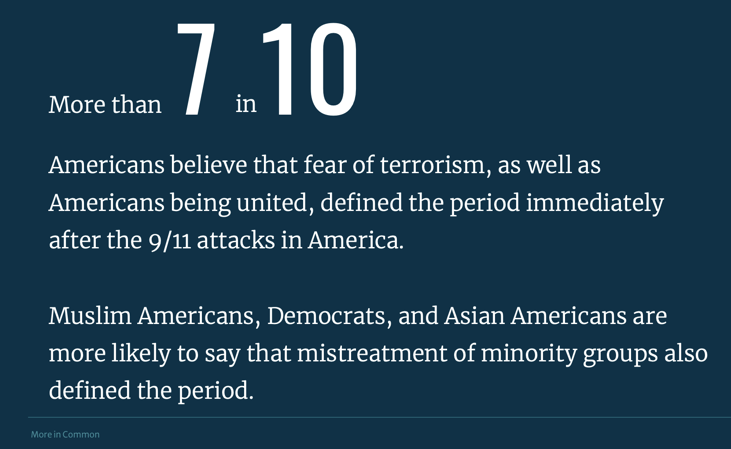 Covering COVID-19 is a daily Poynter briefing of story ideas about the coronavirus and other timely topics for journalists, written by senior faculty Al Tompkins. Sign up here to have it delivered to your inbox every weekday morning.
Covering COVID-19 is a daily Poynter briefing of story ideas about the coronavirus and other timely topics for journalists, written by senior faculty Al Tompkins. Sign up here to have it delivered to your inbox every weekday morning.
I once told my mother that after Sept. 11, 2001, I finally understood her emotions about the attack on Pearl Harbor. Now, 21 years after the 9/11 attacks, the students entering college classes this week will not have been born when America was attacked. New recruits in the military likely will have no memory of the attacks.
You will remember that for a while after 9/11, Americans were united around something, even if that something was tragic.
A new poll by the nonprofit More In Common and research firm YouGov finds:
Close to 7 in 10 Americans say “Never Forget” means we should remember the victims and their families and the sacrifices of first responders on and after 9/11. Approximately 1 in 2 New Yorkers say that “Never Forget” also means we should remember the resilience of New York City and its residents (only 34 percent of Americans in general feel this way). Younger Americans are much more likely to choose “I don’t know” when asked what “Never Forget” means – 15 percent of Generation Z, for example, compared with 4 percent of Baby Boomers, said “I don’t know”.
More than 8 in 10 Americans thought that fear of terrorism and heightened security measures defined the period. 7 in 10 Americans associated the period with Americans being united. Gen Z and Millennials are much less likely than Americans from older generations to describe the post-9/11 nation as patriotic and united.
What journalists need to know about an effort to bring medications to the public faster
The Association of Health Care Journalists provides background on a movement in Congress that would allow drug companies to get medication to the people who need it faster. But it would come with understandable concerns about safety, effectiveness and patient education.
The AHCJ post includes recent studies about how this accelerated program works and how sometimes — even often — the drugs do not pan out as hoped.
In short, with accelerated approval, the FDA and the company make a well-educated guess that positive early data on a drug will prove correct. This promising data often comes from results from the second of three stages of testing, known as phase 2.
Looking at lab tests and imaging reports, for example, researchers may see patterns suggesting experimental drugs are holding tumors in check. With accelerated approval, sales thus can begin earlier for these medicines, while companies continue the research needed to prove they work. This allows more patients, very often facing terminal disease, to try these drugs.
Sometimes this approach works out well for all parties. In these cases, the company proves within a few years that the drug did indeed work as expected. You can see this clearly on a helpful website that the FDA’s cancer division created. (The FDA’s cancer-drug review operations are also called the Oncology Center of Excellence [OCE)]. I tend to avoid this name in writing on the FDA as it seems somewhat promotional.) This website has a database showing cases of “verified benefit” for cancer drugs cleared by accelerated approvals.
But sometimes subsequent studies fail to confirm a benefit for drugs cleared by accelerated approvals. You can use this FDA website to check how many accelerated approvals for cancer drugs have been withdrawn. And the third shows many medicines still need confirmatory trials. You can noodle around with these and get an idea of how long doctors and patients can be left in limbo, waiting to learn whether early promising signals for a medicine were correct.
The AHCJ post includes six key tips for journalists covering this issue. And this is a “fact sheet” published by drug companies that promotes the notion of accelerated medicines
NPR pharmaceuticals correspondent Sydney Lupkin gives us a deep dive into this fast-tracking of drugs and finds:
Many drugs that made it to market with an accelerated approval are being used – sometimes for years – without patients, doctors or regulators knowing if they really work.
While companies making drugs with accelerated approvals drag their feet to start confirmatory studies, they are also more likely to increase the prices of those drugs, according to GoodRx, a website that helps patients get discounts on drugs.
GoodRx conducted a pricing analysis at NPR’s request and found that, on average, drugs granted accelerated approval have 26% more price increases over 10 years than other medicines.
Among the issues are whether patients even know they are using unproven drugs, and whether patients with an illness know there is a drug that they could use that has not run the gauntlet of Food and Drug Administration approval like other medications have. And, of course, should insurance companies cover the cost of medications that have been fast-tracked?
The queen’s corgis

Queen Elizabeth II, with her pet Corgi dogs, leads members of the royal family into Liverpool Street Station in London on Dec. 30, 1966. (AP Photo)
For the last 80 years, one of the constants in Queen Elizabeth’s life has been that she was surrounded by her Pembroke Welsh corgis. By one count, she had 30 of the little dogs in her lifetime, including her beloved Willow, who died in 2018. The Daily Mail reports the queen was particularly upset by Willow’s passing.
“She has mourned every one of her corgis over the years, but she has been more upset about Willow’s death than any of them. … It is probably because Willow was the last link to her parents and a pastime that goes back to her own childhood. It really does feel like the end of an era.”
Elizabeth’s family had a corgi from the time she was 7. She was given her first corgi for her 18th birthday and took that dog, Susan, with her on her honeymoon. She raised 14 generations of corgis descending from Susan. Willow was the last of the bloodline.
She stopped breeding the dogs some years ago, not wanting to have the pups outlive her and leave them for others to care for. Although there has been no official announcement, Royal watchers say they think her remaining four dogs will go to family members.
The Washington Post includes some marvelous corgi and Queen Elizabethphotos from the decades past.
Want to find a corgi club near you? Here you go.
I pass along this tidbit that could well be speculative nonsense, but the Daily Star says, “Cavalier King Charles spaniels are being billed as Britain’s next most popular dog after the Queen’s death.” And the speculation is that the King Charles breed will become the next “thing.” I have my doubts that King Charles’ ascendence will spark such a canine interest, but if the British press says so, it must be true … or not.
The Queen’s approval
Rarely does a head of state find as much public approval as Queen Elizabeth earned. YouGov’s tracking shows the majority of Brits say Elizabeth did a “very good job,” an approval rate that a U.S. president would covet.
The same poll found, “Six in 10 Britons (62%) think Britain should continue to have a monarchy in the future, with only 22% saying the country should move to having an elected head of state instead.” But younger Brits are much less enthusiastic about the monarchy:
Some AP Style reminders for the days ahead
You are going to need this reminder from the Associated Press about how to refer to members of the royal family. Yes, both “royal family” and “royals” are lowercase: The royal household refers to the family and palace officials and staff.
The catio, a porch for cats that could save millions of birds
The Idaho Statesman gives us the story of a movement to promote catios, which are essentially porches for cats who would otherwise run free outside. There are two main motivations behind catios. Free-roaming cats kill about a half billion birds a year, according to the American Bird Conservancy. And outdoor cats live shorter lives than indoor cats because of all the hazards that await them in the wild.
Are electric vehicles straining the power grid? Will they?
State officials are asking Californians not to charge their electric vehicles or use their big appliances while the state sweats through another heat wave and the electrical grid is under stress.
It may seem a little odd that EVs are mentioned in the state’s plea since, as Axios points out, “California had roughly 680,000 registered EVs as of July 1, per S&P Global Mobility, accounting for less than 1% of the state’s total electricity demand. Even if there are 5 million EVs by 2030, they’ll account for about 7% of annual electricity usage and 1% of peak demand, according to the California Air Resources Board.”
Axios also said, “There is plenty of spare capacity in the nation’s electric grid to power hundreds of millions of EVs, multiple studies have found — as long as charging is properly managed. Most EVs charge overnight when people are sleeping and electricity demand is low.”
Sharing stuff without reading it
I have seen this happen so many times. I have written hefty pieces on some issue of complexity and, nearly the instant I post a headline and link on Twitter, somebody shares or comments so quickly that they could not possibly have read the piece.
The Swaddle explores this concept of sharing without knowing. The piece says a new study shows that people who share a lot of stuff on social media might be overestimating how much they know about the issue that is the focus of their sharing.
Titled, “I share, therefore I know?,” and published in the Journal of Consumer Psychology, the study found, “Sharing signals expertise, and people frequently internalize their public behavior into their private self-concepts… [S]haring information on social media may cause people to believe they are as knowledgeable as their posts make them appear.”
A study found that most links shared on social media — 59% — aren’t clicked on at all. This suggests that most of the articles we probably see people in our circles sharing online, aren’t based on any actual reading of the texts.
Another experiment by IFLScience confirms this: in 2016, the website published an article titled, “Marijuana Contains ‘Alien DNA’ From Outside Of Our Solar System, NASA Confirms.” At present, the article has more than 140,000 shares, according to ChemHelps. Interestingly, though, it neither talks about marijuana nor about extra-terrestrial DNA. Instead, it states, “[We] noticed long ago that many of our followers will happily like, share, and offer an opinion on an article — all without ever reading it… We’ve been hoping for a chance to try it ourselves, and this seemed like the perfect opportunity.”
It is fairly common for people on social media to comment on articles based simply on the headline, and without ever clicking to read its body. As IFLScience had further noted, “[T]he top comments often repeat or question something that is fairly explici[t] in the article, but not the headline.”
Now that you have reached the end of today’s column, go ahead and share it, because you can claim to know and share.
We’ll be back next week with a new edition of Covering COVID-19. Are you subscribed? Sign up here to get it delivered right to your inbox.











